Greetings Readers,
After about a month in Italy, my time there had finally come to an end. I took my Italian language final and submitted my last work to Dr. Fleck. Everything was packed up by Wednesday night. We said goodbye to the wait staff and owner of the restaurant around the corner who we had befriended over the course of our stay in Siena. Then, on Thursday morning, we left for Rome.
To get to Rome, we traveled for the better part of a day. Moving a group of seventeen people with at least one piece of luggage each on cramped trains is very stressful. Due to the lack of space on regional trains, a few students and I opted to stay with some of our group’s luggage and just sat on the bags near the door of the compartment. Even though one train was about 20 minutes late, we still managed to catch our connection and arrived at the refurbished monastery, where we were staying, on time. After we moved into our rooms, where we would be living for the next three days, we walked to dinner.
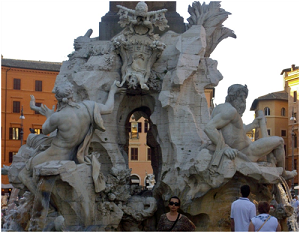 On the way to the restaurant, we passed a number of historical sites, such as The Fountain of Four Rivers.
On the way to the restaurant, we passed a number of historical sites, such as The Fountain of Four Rivers.
 Located in Piazza Navona, the work of art was designed by Gian Lorenzo Bernini in 1651 for Pope Innocent X. Bernini’s work symbolizes the four rivers, the Nile, Danube, Ganges, and Platte, whose continents, Europe, Asia, Africa, and the Americas, throughout which the papal authority had spread. The papal symbol, the two crossed keys, with the crest of the pope can be seen over the arch of the fountain. On top of the combination of architecture and sculpture, there is an Egyptian obelisk.
Located in Piazza Navona, the work of art was designed by Gian Lorenzo Bernini in 1651 for Pope Innocent X. Bernini’s work symbolizes the four rivers, the Nile, Danube, Ganges, and Platte, whose continents, Europe, Asia, Africa, and the Americas, throughout which the papal authority had spread. The papal symbol, the two crossed keys, with the crest of the pope can be seen over the arch of the fountain. On top of the combination of architecture and sculpture, there is an Egyptian obelisk.
On the top of the obelisk, there is a dove with an olive twig, which is the Pamphili family emblem of Pope Innocent X.
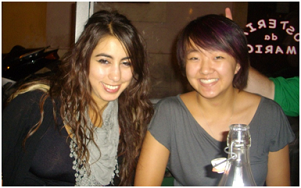 We ate dinner at a small restaurant with outdoor seating. I splurged and ordered a pasta alla carbonara. The dish was made up of pasta, egg, cheese, and bacon. Everybody agreed it was one of the best dishes of the night. While we were waiting for our meal, we took the opportunity to smile for a few photos.
We ate dinner at a small restaurant with outdoor seating. I splurged and ordered a pasta alla carbonara. The dish was made up of pasta, egg, cheese, and bacon. Everybody agreed it was one of the best dishes of the night. While we were waiting for our meal, we took the opportunity to smile for a few photos.
This is a picture of Candace and me.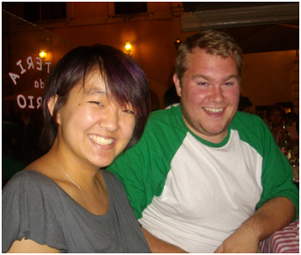 Even though Candace is a few years older than me we got along great. She’s from the ERAU campus in Prescott, Arizona and just graduated with a bachelor’s degree in electrical engineering. Candace is pretty funny and we like a lot of the same things. I was fortunate that she chose to room with me. Oh, and before I forget, the alien antenna is courtesy of Charles. He has a crazy sense of humor, but can also be very pragmatic. Currently he’s studying aeronautical science at the Daytona Beach campus.
Even though Candace is a few years older than me we got along great. She’s from the ERAU campus in Prescott, Arizona and just graduated with a bachelor’s degree in electrical engineering. Candace is pretty funny and we like a lot of the same things. I was fortunate that she chose to room with me. Oh, and before I forget, the alien antenna is courtesy of Charles. He has a crazy sense of humor, but can also be very pragmatic. Currently he’s studying aeronautical science at the Daytona Beach campus.
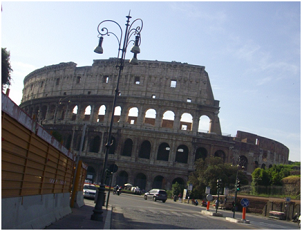 The next morning we started out bright and early. The first ancient building that we visited was the Colosseum.
The next morning we started out bright and early. The first ancient building that we visited was the Colosseum.
The elliptical amphitheater was completed in 80 AD and could seat up to 50,000 people. The Colosseum was used for gladiator fights, mock sea battles, executions, dramas, and hunting wild animals. The participants, such as people and 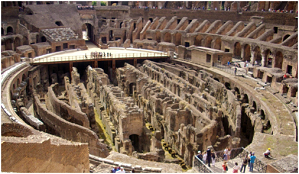 animals, in these public entertainments were housed in the hypogeum, a series of tunnels and cages underneath the floor of the main arena. In addition, there also used to be underground passages that connected the Colosseum to Ludus Magnus, a school where gladiators trained.
animals, in these public entertainments were housed in the hypogeum, a series of tunnels and cages underneath the floor of the main arena. In addition, there also used to be underground passages that connected the Colosseum to Ludus Magnus, a school where gladiators trained.
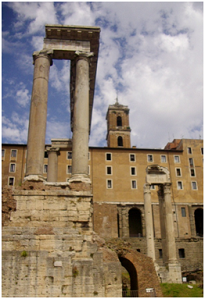
By this time of the day, the sun was high overhead and it was very warm. Luckily, on the way to our next destination, we were able to stop and get cool water from one of Rome’s many fountains. From there, we proceeded to walk inside the old Roman Forum.
This area contains the ruins of government buildings and used to be the center of ancient Rome. Commerce, business, and the administration of justice all took place here in the rectangular plaza located between the Palatine and Capitoline Hills. It was here that the Roman Republican government, an ancestor to the administration of the U.S., began. 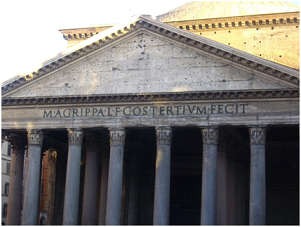
Following the Roman Forum, we went to the Pantheon.
The inscription on the front translates roughly to “Marcus Agrippa son of Lucius, having been consul three times made it.” The pediment, the triangular top stone, used to contain sculpture depicting the battle of the Titans. The dome is made up of a series of intersecting arches. The heaviest building materials were used at the base of the structure while the lightest, such as pumice, were used at the top. The highest point of the dome is actually an oculus, a circular opening in the center of the roof, is lined with bronze and lets in natural light.
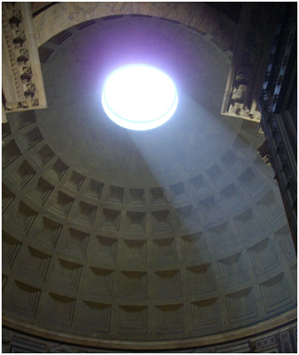
The Pantheon was created to honor the pagan gods of ancient Rome. Today, however, it is used to house the tombs of Italian kings and the famous Renaissance painter Raphael.
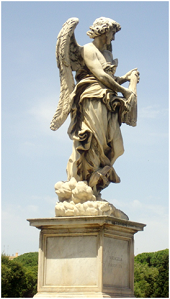
From the Pantheon, we made our way across the city to the Vatican. Along the way, we crossed Ponte Sant’Angelo. The bridge spans the Tiber River and was completed in 134 AD by the Emperor Hadrian.
In 1669, Pope Clement IX commissioned Gian Lorenzo Bernini to create a series of ten angels holding the instruments of Christ’s Passion. These tools include, but are not limited to, the crown of thorns, nail, cross, and lance.
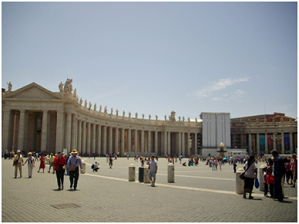 Eventually, we reached the Vatican. Vatican City is the smallest independent state in the world. It is here that the Pope, Pope Benedict XVI, lives. He is not only the Bishop of Rome, but also the head of the Catholic Church. One of the main entrances into the Vatican is St. Peter’s Square.
Eventually, we reached the Vatican. Vatican City is the smallest independent state in the world. It is here that the Pope, Pope Benedict XVI, lives. He is not only the Bishop of Rome, but also the head of the Catholic Church. One of the main entrances into the Vatican is St. Peter’s Square.
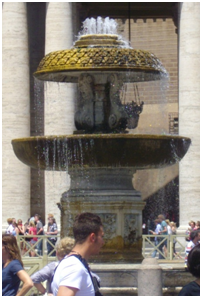
This piazza was also designed by Bernini, who was one of the most important artists in the baroque art movement. Visitor’s quickly realized that the square is clearly baroque due to the elliptical shape of the square and the elaborate, fancy stone work and design. In fact, Bernini used properties of the ellipse in creating St. Peter’s Square. For example, at each focus of the shape, he placed two fountains.
In the center, where the major and minor axes cross, he placed an Egyptian obelisk made out of red granite. The piazza is outlined in colonnades, rows of columns, which wrap around the square and symbolize the Catholic Church embracing visitors and worshippers alike in maternal arms. After we saw the square, we visited the Vatican Museum, which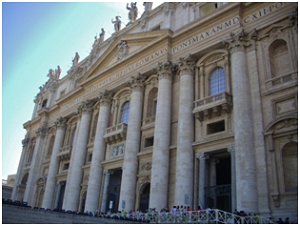 did not allow pictures. We saw Raphael’s School of Athens, which is a fresco depicting almost every great Greek philosopher. We were also able to visit the Sistine Chapel and see Michelangelo’s famous fresco on the ceiling. One of the many stories featured in the work of art is the story of Adam and Eve. The panel illustrating The Creation of Adam shows God reaching out to touch fingers with Adam. God appears to be reaching out of a human brain to perform this action, displaying Michelangelo’s knowledge of human anatomy. This gives evidence to the thought that the great Renaissance artist performed human autopsies even though they were illegal at the time.
did not allow pictures. We saw Raphael’s School of Athens, which is a fresco depicting almost every great Greek philosopher. We were also able to visit the Sistine Chapel and see Michelangelo’s famous fresco on the ceiling. One of the many stories featured in the work of art is the story of Adam and Eve. The panel illustrating The Creation of Adam shows God reaching out to touch fingers with Adam. God appears to be reaching out of a human brain to perform this action, displaying Michelangelo’s knowledge of human anatomy. This gives evidence to the thought that the great Renaissance artist performed human autopsies even though they were illegal at the time.
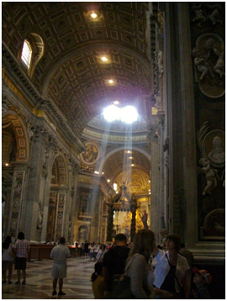 After spending hours in the Vatican Museum, and getting lost multiple times, we exited the building and entered St. Peter’s Basilica.
After spending hours in the Vatican Museum, and getting lost multiple times, we exited the building and entered St. Peter’s Basilica.
It is the largest Christian Church in the world and is one of the holiest sites of Christianity. Each year, many people make a pilgrimage to visit St. Peter’s Basilica.
This church is cruciform in shape and contains multiple chapels, altars, and tombs of popes. In the picture, Bernini’s baldacchino, the canopy over the papal altar, is visible. The four huge undulating columns are made of bronze and the work as a whole is the epitome of baroque architecture.
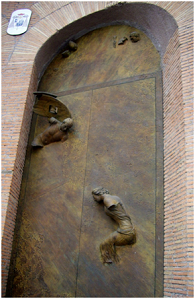 Following our visit to the Vatican, we returned to the refurbished monastery and recovered from the twelve hours of walking and incredible heat and humidity. While resting in my room, I contacted my friend John who is stationed in Naples with the Navy. I first met John four years ago on a People to People trip to the United Kingdom and Ireland. We kept in contact over the years and he was ecstatic to find out that I would be in Italy. He decided to come and visit while I was in Rome. That evening, a group of my fellow students and I met John and his friend at the Rome Hard Rock Café. We ate and talked the night away. After saying goodbye to John and leaving the restaurant, we decided to use the Roman metro system because we thought it would be an easier way to get back to the monastery. Unfortunately, certain subway lines only run until about 10 PM. While we’re not exactly sure how, we ended up on the back side of the Vatican, which was off our map. Eventually after walking around for about an hour to an hour and a half, we found our way back to the residence.
Following our visit to the Vatican, we returned to the refurbished monastery and recovered from the twelve hours of walking and incredible heat and humidity. While resting in my room, I contacted my friend John who is stationed in Naples with the Navy. I first met John four years ago on a People to People trip to the United Kingdom and Ireland. We kept in contact over the years and he was ecstatic to find out that I would be in Italy. He decided to come and visit while I was in Rome. That evening, a group of my fellow students and I met John and his friend at the Rome Hard Rock Café. We ate and talked the night away. After saying goodbye to John and leaving the restaurant, we decided to use the Roman metro system because we thought it would be an easier way to get back to the monastery. Unfortunately, certain subway lines only run until about 10 PM. While we’re not exactly sure how, we ended up on the back side of the Vatican, which was off our map. Eventually after walking around for about an hour to an hour and a half, we found our way back to the residence.
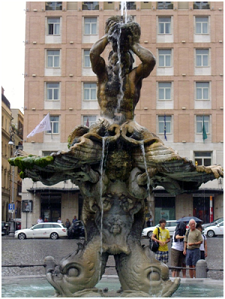 During the morning of our last day in Rome, the first place we visited was the Baths of Diocletian.
During the morning of our last day in Rome, the first place we visited was the Baths of Diocletian.
They used to be the most impressive baths in all of Rome and were the largest of the imperial pools. Today, even though some parts of the building have been preserved as baths, other rooms have been converted for other uses. For example, in one of the two circular rooms has been converted into a church, while the frigidarium, where the cold pools were located, is now a basilica. Other parts of the building are now part of the Roman National Museum.
When we left the baths, we walked across the Piazza Barberini, at the center of which is the Triton Fountain.
The statue was commissioned by Pope Urban VIII and created by Bernini in 1642. Triton was a sea god in Greco-Roman legends. The sea god rests on the tails of four dolphins that are intertwined with the papal symbol of the crossed keys and the Barberini family crest of the three bees. Originally, the spout of water used to be much higher. This, in combination of the pose of the Triton, makes the fountain very dramatic.
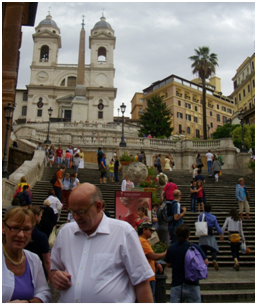 The last tourist attraction we visited as a group with our professors was the Spanish Steps.
The last tourist attraction we visited as a group with our professors was the Spanish Steps.
This is the widest staircase in all of Europe and spans from the Piazza di Spagna to the Piazza Trinita dei Monti. It was at this point in time, that Professor Fleck and his wife said goodbye to us and left. The group of study abroad students said their goodbyes as well and separated. Some people needed to catch trains or the subway to get back to the airport. Others had the rest of the day to spend in Rome doing whatever we wanted. For me, that meant visiting the Borghese Gallery to examine the Bernini’s most famous works.
Part of my honors course work included an in-depth paper that would further examine a topic studied in class. I chose to study Gian Lorenzo Bernini’s marble statue Apollo and Daphne. Bernini was truly a genius when it came to sculpture. From the sheer amount of detail of Daphne’s fingers transforming into leaves to the look on her face as Apollo catches her, Bernini is amazing. The Borghese Gallery also had Bernini’s David, Pluto and Proserpina, and multiple works of Caravaggio, another great baroque artist. Originally, I thought that my two hour ticket would be ample time to example all of the works in the gallery. However, I found that I was one of the last people to leave and I only saw the first floor. It could be my honors geek speaking, but I thoroughly enjoyed myself just staring at Apollo and Daphne. If you ever find yourself in Rome and have some spare time, I most definitely recommend that you visit the Borghese Gallery.



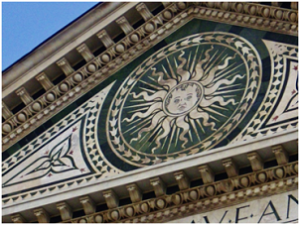
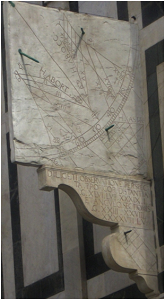 In the past, people used this decoration as a tool to tell then when important seasons and holidays were occuring based on the location of the shadows cast by the pins on the chart. In additon, Basilica of Santa Maria Novella is the first church to have volutes, or scrolls, located on either side of the pediment. These s-shaped decorations can be found on churches all over Italy and later were an important feature of Baroque architecture.
In the past, people used this decoration as a tool to tell then when important seasons and holidays were occuring based on the location of the shadows cast by the pins on the chart. In additon, Basilica of Santa Maria Novella is the first church to have volutes, or scrolls, located on either side of the pediment. These s-shaped decorations can be found on churches all over Italy and later were an important feature of Baroque architecture.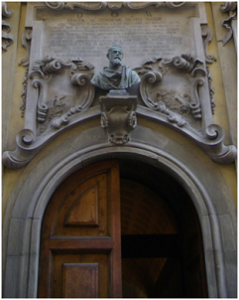 While we walked around Florence, we saw multiple busts of Galileo.
While we walked around Florence, we saw multiple busts of Galileo.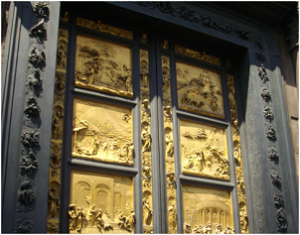 next destination was Lorenzo Ghiberti’s Gates of Paradise.
next destination was Lorenzo Ghiberti’s Gates of Paradise.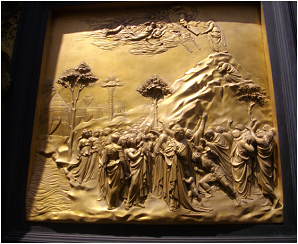 he Old Testament.
he Old Testament.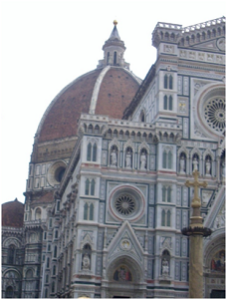
 attraction in Florence was two hours. Around midday, we entered the Uffizi Museum.
attraction in Florence was two hours. Around midday, we entered the Uffizi Museum.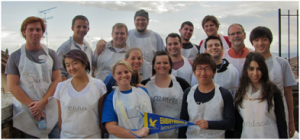
 Here are some students getting ready to eat. Picture courtesy of Bonnie Pratt. In the above picture, the blond woman is Dr. Pratt’s wife, Bonnie. She’s really nice and a favorite of the students. She enjoyed our meal. The noodles we made were by far the best noodles I have had while in Italy so far. Our meal lasted until around 10 PM at which we returned to our residence and went to bed in preparation for Luca’s class the next day.
Here are some students getting ready to eat. Picture courtesy of Bonnie Pratt. In the above picture, the blond woman is Dr. Pratt’s wife, Bonnie. She’s really nice and a favorite of the students. She enjoyed our meal. The noodles we made were by far the best noodles I have had while in Italy so far. Our meal lasted until around 10 PM at which we returned to our residence and went to bed in preparation for Luca’s class the next day.
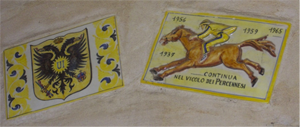 The stable of the Eagle contrada. The racetrack goes around the Piazza del Campo, the Siena’s city center. The race circles the Campo three times and typically lasts less than two minutes. Sometimes the goal of the jockeys is to keep the rival contrada from winning and sometimes jockeys are thrown from their horse. Luckily, the winner of the Palio is the first horse that crosses the finish line, not the rider. The loser of the race is considered to be the horse that came in second, not last. This is because the second place horse came so close to winning but failed to do so. We had multiple classes that taught us about the contrade and the Palio. Another part of our classes consisted of visiting different cities in Italy.
The stable of the Eagle contrada. The racetrack goes around the Piazza del Campo, the Siena’s city center. The race circles the Campo three times and typically lasts less than two minutes. Sometimes the goal of the jockeys is to keep the rival contrada from winning and sometimes jockeys are thrown from their horse. Luckily, the winner of the Palio is the first horse that crosses the finish line, not the rider. The loser of the race is considered to be the horse that came in second, not last. This is because the second place horse came so close to winning but failed to do so. We had multiple classes that taught us about the contrade and the Palio. Another part of our classes consisted of visiting different cities in Italy.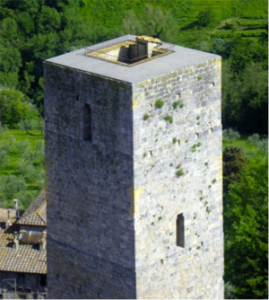 One of San Gimignano’s remaining towers. At one point in time, the city had as many as seventy two towers. The largest of these were around fifty meters tall. It is thought that affluent families would have towers built to show their wealth and supremacy. Currently, however, there are only fourteen towers still standing. The others were taken down due to wear, rebuilding, and wars. In the past, whenever a city was captured, the conquerors would knock down the town’s tower to symbolize the loss of power. During our trip to the city, we took the time to climb up San Gimignano’s tallest tower in order to view the beautiful Tuscan landscape. We could see the rolling hills, neighboring towns, vineyards, and rows upon rows of olive trees.
One of San Gimignano’s remaining towers. At one point in time, the city had as many as seventy two towers. The largest of these were around fifty meters tall. It is thought that affluent families would have towers built to show their wealth and supremacy. Currently, however, there are only fourteen towers still standing. The others were taken down due to wear, rebuilding, and wars. In the past, whenever a city was captured, the conquerors would knock down the town’s tower to symbolize the loss of power. During our trip to the city, we took the time to climb up San Gimignano’s tallest tower in order to view the beautiful Tuscan landscape. We could see the rolling hills, neighboring towns, vineyards, and rows upon rows of olive trees.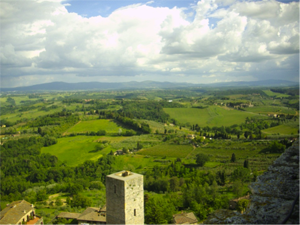 A view of Tuscany from the tallest tower of San Gimignano. Later that same week, we visited Venice. The city is built on top of 118 small islands that are connected by bridges and canals. The city, and the lagoon it rests in, is considered a World Heritage Site.
A view of Tuscany from the tallest tower of San Gimignano. Later that same week, we visited Venice. The city is built on top of 118 small islands that are connected by bridges and canals. The city, and the lagoon it rests in, is considered a World Heritage Site.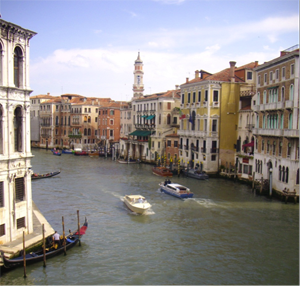 The Grand Canal, one of the main waterways of the city. This picture was taken from the Scalzi Bridge. During the Middle Ages and the Renaissance, Venice was a major maritime power and an important center of commerce due to the city’s location directly on the water. Furthermore, the metropolis was also the origin of many important artistic movements and styles, such as the Renaissance and the Venetian School. Presently, this town is very famous for its Venetian glass and the Carnival of Venice, which is when people wear intricate and beautiful masks.
The Grand Canal, one of the main waterways of the city. This picture was taken from the Scalzi Bridge. During the Middle Ages and the Renaissance, Venice was a major maritime power and an important center of commerce due to the city’s location directly on the water. Furthermore, the metropolis was also the origin of many important artistic movements and styles, such as the Renaissance and the Venetian School. Presently, this town is very famous for its Venetian glass and the Carnival of Venice, which is when people wear intricate and beautiful masks.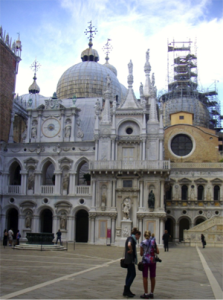 This is a view from the inner courtyard of the Doge’s Palace. My favorite exhibit in the museum was about medieval warfare. The display had many artifacts and was quite expansive. There were full suits of armor for people and horses, swords, daggers, crossbows, guns, spears, and so much more. Since my father loves knights, I grew up adoring castles and watching films about the Middle Ages. I was very disappointed to find out that I was not allowed to take pictures of the collection. I must have spent up to two hours in the museum.
This is a view from the inner courtyard of the Doge’s Palace. My favorite exhibit in the museum was about medieval warfare. The display had many artifacts and was quite expansive. There were full suits of armor for people and horses, swords, daggers, crossbows, guns, spears, and so much more. Since my father loves knights, I grew up adoring castles and watching films about the Middle Ages. I was very disappointed to find out that I was not allowed to take pictures of the collection. I must have spent up to two hours in the museum.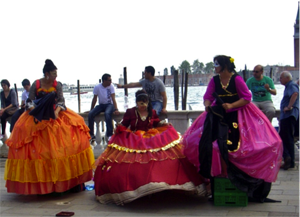 Three people putting on their Carnival of Venice costumes. When I was walking around Venice from island to island across the bridges, I noticed that some of the crossings had locks attached to them. These locks usually had two names written on them and the date of when the lock was placed on the bridge. Sometimes there were even inscriptions about love lasting forever, giving them the name “love locks”.
Three people putting on their Carnival of Venice costumes. When I was walking around Venice from island to island across the bridges, I noticed that some of the crossings had locks attached to them. These locks usually had two names written on them and the date of when the lock was placed on the bridge. Sometimes there were even inscriptions about love lasting forever, giving them the name “love locks”.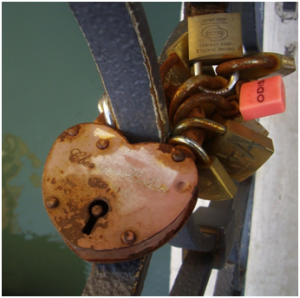 Some of the many love locks that I saw attached bridges. The idea behind the love locks is that two sweethearts engrave their names onto a padlock and attach it to a public fixture such as a bridge, gate, fence, etc. and throw away the key. Since the lock cannot ever be removed, this symbolizes their undying love for each other. While an appealing idea, these love locks are considered to be controversial. Some people do not like them because they build up over time and can affect the aesthetic quality of public places.
Some of the many love locks that I saw attached bridges. The idea behind the love locks is that two sweethearts engrave their names onto a padlock and attach it to a public fixture such as a bridge, gate, fence, etc. and throw away the key. Since the lock cannot ever be removed, this symbolizes their undying love for each other. While an appealing idea, these love locks are considered to be controversial. Some people do not like them because they build up over time and can affect the aesthetic quality of public places.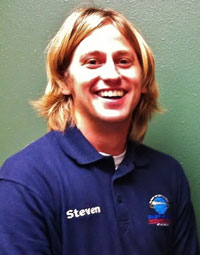 Before I get started about my travels to Siena, Italy and my experiences, I have one order of business to take care of. My previous entry mentioned Steven Bohlemann, a student who works in the Study Abroad Office, but I was not able to get a picture of him in time before I turned the journal admission. As promised, here is a picture of Steven (courtesy of the Study Abroad Office in Daytona Beach).
Before I get started about my travels to Siena, Italy and my experiences, I have one order of business to take care of. My previous entry mentioned Steven Bohlemann, a student who works in the Study Abroad Office, but I was not able to get a picture of him in time before I turned the journal admission. As promised, here is a picture of Steven (courtesy of the Study Abroad Office in Daytona Beach).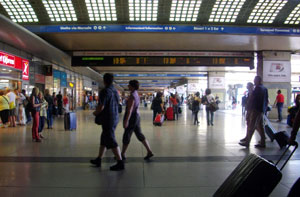 The most nerve wracking event I experienced was when my train was fifteen minutes late. When this occurs, passengers neither know when exactly their train will arrive, nor do they know the platform, or binario, where their train will be located. To make matters worse, I only had a fifteen minute layover between trains in Chiusi Chianciano. Luckily, my delay did not cause me to miss my second train to Siena. After I arrived at the train station, I took a taxi cab to the Residenza San Domenico, the place where students are housed.
The most nerve wracking event I experienced was when my train was fifteen minutes late. When this occurs, passengers neither know when exactly their train will arrive, nor do they know the platform, or binario, where their train will be located. To make matters worse, I only had a fifteen minute layover between trains in Chiusi Chianciano. Luckily, my delay did not cause me to miss my second train to Siena. After I arrived at the train station, I took a taxi cab to the Residenza San Domenico, the place where students are housed.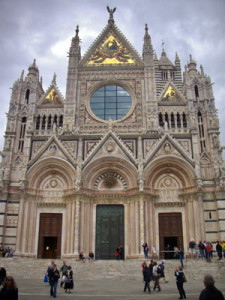 The rooms at Residenza San Domenico are decently furnished. Rooms can house anywhere from two to four students depending on the room. My roommate is a girl from Prescott, Daytona’s sister campus, named Candace. We get along great. No two rooms are alike, but each has a bathroom with a large wardrobe that contains a small kitchenette unit that houses a large sink and hotplate. In addition, silverware, dishes, and cups are provided with the rooms. Some rooms have lofts and others will have large closets and drawers. One of the rooms meant for students has a phenomenal view of neighborhoods across the valley as well as the Duomo, a large gothic church located on of the other hills of Siena.
The rooms at Residenza San Domenico are decently furnished. Rooms can house anywhere from two to four students depending on the room. My roommate is a girl from Prescott, Daytona’s sister campus, named Candace. We get along great. No two rooms are alike, but each has a bathroom with a large wardrobe that contains a small kitchenette unit that houses a large sink and hotplate. In addition, silverware, dishes, and cups are provided with the rooms. Some rooms have lofts and others will have large closets and drawers. One of the rooms meant for students has a phenomenal view of neighborhoods across the valley as well as the Duomo, a large gothic church located on of the other hills of Siena.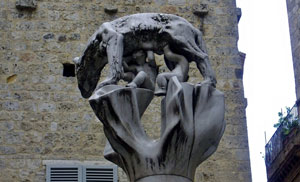 According to the legend, Romulus, the found of Rome, had two sons, Senius and Aschius. It was these two men who founded Siena. Their colors, white and black, are displayed on the flag of the city and in the colors of the Duomo. On one side, there is an outcropping of red brick and a black and white marble wall. According to my professors, the church was supposed to be much larger than it is today. Work on the expansion halted when Siena was struck by the bubonic plague, which killed about two thirds of the population. I walk by the Duomo every day on the way to class.
According to the legend, Romulus, the found of Rome, had two sons, Senius and Aschius. It was these two men who founded Siena. Their colors, white and black, are displayed on the flag of the city and in the colors of the Duomo. On one side, there is an outcropping of red brick and a black and white marble wall. According to my professors, the church was supposed to be much larger than it is today. Work on the expansion halted when Siena was struck by the bubonic plague, which killed about two thirds of the population. I walk by the Duomo every day on the way to class.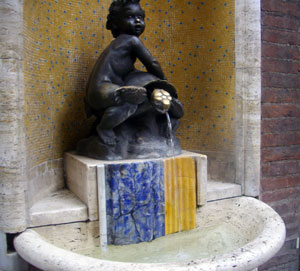 The other class is run by Embry-Riddle. At 9 AM, I take an Italian language class with Massimiliano, an Italian professor. Our learning consists of using a text and workbook along with supplementary lessors. We have learned a lot so far. Typically we have a short 30 minute break at 11AM. This is when most students eat lunch. At 11:30, we either have Massimiliano again or we study Italian culture under Dr. Luca Bonomi, the director of Dante Alighieri. When we have Luca, we usually have a short presentation in class and then he takes us outdoors to walk around and explore Siena. We have visited the Piazza del Campo, which is the city center, as well as the main political buildings. One day, we even analyzed Italian body language and what each of the subtle nuances mean. It was fascinating. After either another session with Massimiliano or Luca, we get another short break of about 15 minutes or so at 1:30 PM. Then we are taught by ERAU professors Dr. Alan Pratt or Dr. Robert Fleck. Dr. Pratt teaches art history, which occurs during the first two weeks of our session. He tries very hard to make sure that we are getting the most out of our studies with daily quizzes that require one word answer and consists of about 15 questions. After Dr. Pratt leaves, we study under Dr. Fleck who teaches Italian contributions to both art and science. Professor Fleck is a high energy teacher. It is quite evident that he is passionate about science. One day, he even tried to draw the solar system on the classroom floor while jumping about in an Einstein t-shirt. He is very entertaining. The end of our day can occur as early as 2:30 PM and as late as 4 PM. It just depends on the day. Luckily, we get three day weekends.
The other class is run by Embry-Riddle. At 9 AM, I take an Italian language class with Massimiliano, an Italian professor. Our learning consists of using a text and workbook along with supplementary lessors. We have learned a lot so far. Typically we have a short 30 minute break at 11AM. This is when most students eat lunch. At 11:30, we either have Massimiliano again or we study Italian culture under Dr. Luca Bonomi, the director of Dante Alighieri. When we have Luca, we usually have a short presentation in class and then he takes us outdoors to walk around and explore Siena. We have visited the Piazza del Campo, which is the city center, as well as the main political buildings. One day, we even analyzed Italian body language and what each of the subtle nuances mean. It was fascinating. After either another session with Massimiliano or Luca, we get another short break of about 15 minutes or so at 1:30 PM. Then we are taught by ERAU professors Dr. Alan Pratt or Dr. Robert Fleck. Dr. Pratt teaches art history, which occurs during the first two weeks of our session. He tries very hard to make sure that we are getting the most out of our studies with daily quizzes that require one word answer and consists of about 15 questions. After Dr. Pratt leaves, we study under Dr. Fleck who teaches Italian contributions to both art and science. Professor Fleck is a high energy teacher. It is quite evident that he is passionate about science. One day, he even tried to draw the solar system on the classroom floor while jumping about in an Einstein t-shirt. He is very entertaining. The end of our day can occur as early as 2:30 PM and as late as 4 PM. It just depends on the day. Luckily, we get three day weekends.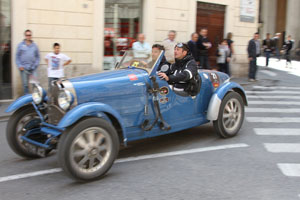 During my first weekend in Siena, while I was walking around with my friend Nathan, I saw an old car race.
During my first weekend in Siena, while I was walking around with my friend Nathan, I saw an old car race.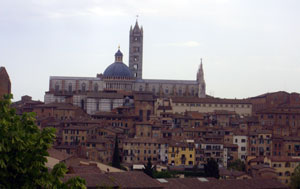
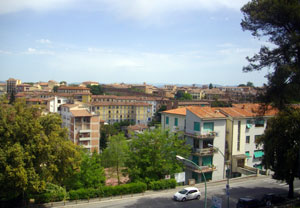
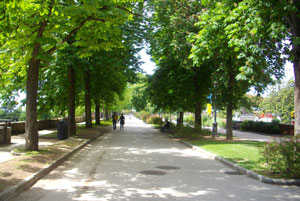
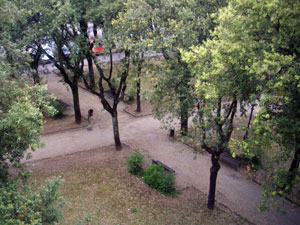
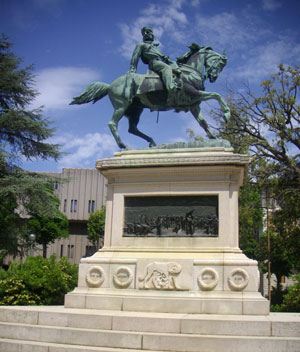
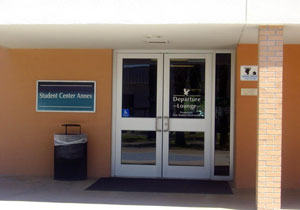 I initially heard of the organization during the fall activities fair that took place near the beginning of first semester. Steven Bohlemann, a student who works in the Study Abroad Office, had a table set up with pictures, posters, and flyers. He was the one who suggested that I look online at the
I initially heard of the organization during the fall activities fair that took place near the beginning of first semester. Steven Bohlemann, a student who works in the Study Abroad Office, had a table set up with pictures, posters, and flyers. He was the one who suggested that I look online at the 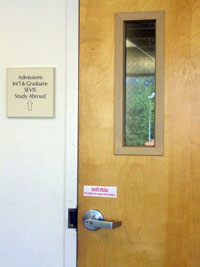 After entering, climb the stairs and look for a plain wooden door almost directly across the room from the staircase. Go through the door and proceed down the hallway until there is a branch to the right that has a sign reading “Study Abroad”.
After entering, climb the stairs and look for a plain wooden door almost directly across the room from the staircase. Go through the door and proceed down the hallway until there is a branch to the right that has a sign reading “Study Abroad”.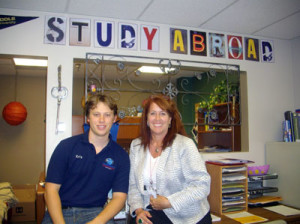 Furthermore, since I am in the Honors Program, Study Abroad also satisfies my HON 350 requirement. I was elated to find out that not only was I able to make my semester course load lighter and more manageable, but studying abroad cost less that attending Summer A on campus at ERAU. I found out this information and other helpful factoids when I attended Study Abroad meetings.
Furthermore, since I am in the Honors Program, Study Abroad also satisfies my HON 350 requirement. I was elated to find out that not only was I able to make my semester course load lighter and more manageable, but studying abroad cost less that attending Summer A on campus at ERAU. I found out this information and other helpful factoids when I attended Study Abroad meetings.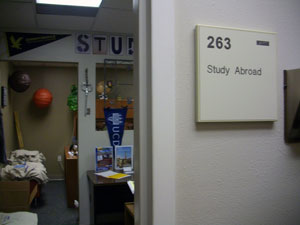 on, I went through my suitcase yet another time to minimize the weight. This will make it easier to travel in Europe, where I will have to haul my own luggage multiple city blocks to get to my destination, Residenza San Domenico. At the end of this week, I will wake up at 4:30am and board an airplane to Houston. The first of three flights to Italy!
on, I went through my suitcase yet another time to minimize the weight. This will make it easier to travel in Europe, where I will have to haul my own luggage multiple city blocks to get to my destination, Residenza San Domenico. At the end of this week, I will wake up at 4:30am and board an airplane to Houston. The first of three flights to Italy!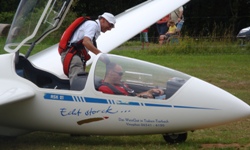 After taking the train out of Munich, we arrived in the small town of Traben-Trarbach around lunch on the 13th. We dropped off our things at the quaint little hotel, and headed up to Mont Royal for our glider flights! I was a little nervous about being shot up in the air, and I let a lot of people go before me. However I finally gathered my courage, put on my parachute, and climbed into the glider. The take off was pretty intense, but it was a beautiful view and definitely a fun ride!!! I am very glad to have done this, and I definitely believe this was one of the highlights of the trip. You can check out the video of my take off from the airfield at
After taking the train out of Munich, we arrived in the small town of Traben-Trarbach around lunch on the 13th. We dropped off our things at the quaint little hotel, and headed up to Mont Royal for our glider flights! I was a little nervous about being shot up in the air, and I let a lot of people go before me. However I finally gathered my courage, put on my parachute, and climbed into the glider. The take off was pretty intense, but it was a beautiful view and definitely a fun ride!!! I am very glad to have done this, and I definitely believe this was one of the highlights of the trip. You can check out the video of my take off from the airfield at 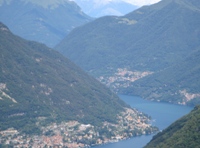
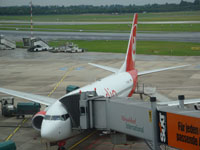 On Friday we flew from Paris to Munich to begin the Germany section of the trip. The flights had been booked for us, and we got to take Air Berlin (check out the picture). I was very impressed by this low-cost European carrier, and will certainly fly them any time I can in the future. Upon arrival, we got checked into our hostel and only had a few hours remaining in the day. A few friends and I headed straight for the city center of Munich, known as Marienplatz. It was definitely the liveliest area in the city, and had a lot of things to see and do. After a nice dinner we headed back to our comfortable room to get prepared for the next day.
On Friday we flew from Paris to Munich to begin the Germany section of the trip. The flights had been booked for us, and we got to take Air Berlin (check out the picture). I was very impressed by this low-cost European carrier, and will certainly fly them any time I can in the future. Upon arrival, we got checked into our hostel and only had a few hours remaining in the day. A few friends and I headed straight for the city center of Munich, known as Marienplatz. It was definitely the liveliest area in the city, and had a lot of things to see and do. After a nice dinner we headed back to our comfortable room to get prepared for the next day.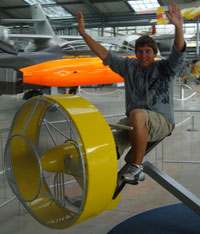 Saturday afternoon, we headed back into central Munich to the main Deutches Museum building, which included airplanes but had also many other displays. At this museum, we got to see many different military aircraft from Germany. Also, there was a Lufthansa Boeing 707 cockpit that you could see into. It is very cool to notice the huge differences in cockpits from many years ago when compared to cockpits of today. Another interesting display was the section on German air traffic control. Aside from the aviation part of the museum, we were encouraged to stay after the session and check out the rest of the exhibits. This museum was certainly one of my favorites and housed exhibits on nearly any technological advancement you could imagine. Some things covered were aviation, space exploration, boating and navigation, nuclear energy, computers, assembly lines, robotics, and thousands of other items. The never-ending array of information was fascinating, and I could have spent a much longer time at the Deutches Museum.
Saturday afternoon, we headed back into central Munich to the main Deutches Museum building, which included airplanes but had also many other displays. At this museum, we got to see many different military aircraft from Germany. Also, there was a Lufthansa Boeing 707 cockpit that you could see into. It is very cool to notice the huge differences in cockpits from many years ago when compared to cockpits of today. Another interesting display was the section on German air traffic control. Aside from the aviation part of the museum, we were encouraged to stay after the session and check out the rest of the exhibits. This museum was certainly one of my favorites and housed exhibits on nearly any technological advancement you could imagine. Some things covered were aviation, space exploration, boating and navigation, nuclear energy, computers, assembly lines, robotics, and thousands of other items. The never-ending array of information was fascinating, and I could have spent a much longer time at the Deutches Museum.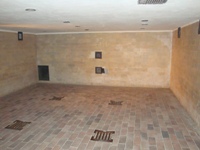 After a long Saturday of work, we were rewarded with a free day to end the weekend. I started my day on a free walking tour and saw a lot of the city. Some of the better sites included the Hofbrahaus, Glockenspiel, Frauenkirche, Mozart’s temporary home, and the City Hall. Although those sites were quite breathtaking, they didn’t even compare to what I was about to experience. That afternoon I hopped on a train and decided to visit the Dachau Concentration Camp outside of Munich. From the moment I arrived I felt the power of such a devastating place. The barracks, the showers, the washrooms, and the museum were almost too much to handle. And then, when I thought I had seen it all, we stepped into the gas chamber and crematorium. The entire time I visited the site I couldn’t help but feel saddened by certainly one of the low points of the human race. However, it was quite a sobering experience, and I certainly will never forget how I felt and what I saw at Dachau.
After a long Saturday of work, we were rewarded with a free day to end the weekend. I started my day on a free walking tour and saw a lot of the city. Some of the better sites included the Hofbrahaus, Glockenspiel, Frauenkirche, Mozart’s temporary home, and the City Hall. Although those sites were quite breathtaking, they didn’t even compare to what I was about to experience. That afternoon I hopped on a train and decided to visit the Dachau Concentration Camp outside of Munich. From the moment I arrived I felt the power of such a devastating place. The barracks, the showers, the washrooms, and the museum were almost too much to handle. And then, when I thought I had seen it all, we stepped into the gas chamber and crematorium. The entire time I visited the site I couldn’t help but feel saddened by certainly one of the low points of the human race. However, it was quite a sobering experience, and I certainly will never forget how I felt and what I saw at Dachau.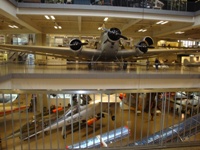 Munich has been a great way to begin our visit in Germany. I have really enjoyed the city’s liveliness and culture. The German language is very different, but I am having fun trying to use some of what I learned prior to leaving. I am excited to head out to Traben-Trarbach, where our group will take a glider flight. I hope you have enjoyed my Europe journals, and if you have any questions about the trip or something else, email me at
Munich has been a great way to begin our visit in Germany. I have really enjoyed the city’s liveliness and culture. The German language is very different, but I am having fun trying to use some of what I learned prior to leaving. I am excited to head out to Traben-Trarbach, where our group will take a glider flight. I hope you have enjoyed my Europe journals, and if you have any questions about the trip or something else, email me at 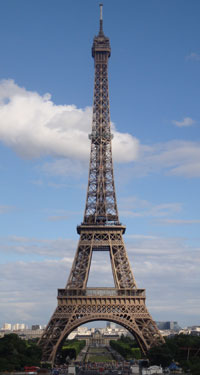 After the fast train ride we checked into our hotel and headed to the Louvre for a group cultural experience. The Louvre displays sucha wide variety of works of art from all different time periods andplaces all over the world. It’s a bit overwhelming to try to grip theimportance and historical value of everything you see. A few of thethousands exhibits included Michelangelo’s Dying Slave and Da Vinci’s Mona Lisa. I really appreciate the effort of Professor Kirton to make the cultural events part of the course. Not only have I learned a lot about aviation, but also I have broadened my global thinking.
After the fast train ride we checked into our hotel and headed to the Louvre for a group cultural experience. The Louvre displays sucha wide variety of works of art from all different time periods andplaces all over the world. It’s a bit overwhelming to try to grip theimportance and historical value of everything you see. A few of thethousands exhibits included Michelangelo’s Dying Slave and Da Vinci’s Mona Lisa. I really appreciate the effort of Professor Kirton to make the cultural events part of the course. Not only have I learned a lot about aviation, but also I have broadened my global thinking.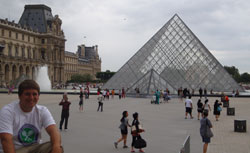 Thursday was our free day at Paris, and we accomplished a lot. A group of five of us visited Notre Dame, the Sacre Couer, Centre Pompidou, and the top of the Eiffel Tower. Each attraction was a little different, but I found all of them very interesting. Although they are quite close geographically, the cities of Paris and London feel worlds apart. I love both of them, but I still believe London ranks higher for me. Tomorrow however, we are switching it up again as we fly to Munich to begin our German section of the trip.
Thursday was our free day at Paris, and we accomplished a lot. A group of five of us visited Notre Dame, the Sacre Couer, Centre Pompidou, and the top of the Eiffel Tower. Each attraction was a little different, but I found all of them very interesting. Although they are quite close geographically, the cities of Paris and London feel worlds apart. I love both of them, but I still believe London ranks higher for me. Tomorrow however, we are switching it up again as we fly to Munich to begin our German section of the trip.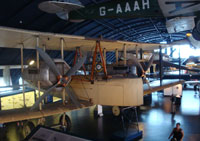 The afternoon of our arrival (July 2), we all met at the British Science Museum for our first session. The museum has a great display of all different types of aircraft and parts. One of the most interesting planes was the Vickers Vimy (pictured), which was the first plane to cross the Atlantic Ocean. It was a larger plane for its day, and had some pretty impressive specifications. My other favorite display was a cross section cut out of a British Airways 747 jet. It interested me greatly to see all of the inner workings of the commercial aircraft. The next day (July 3), we headed off to the Imperial War Museum north of London. The train and bus rides to Duxford took a little while, but the wait was well worth it. My true love of aviation is in commercial aviation, and this museum had many commercial displays. I really enjoyed the British Oversees Airways Corporation (BOAC) BAC-VC10. I had never heard or read too much about this aircraft, but it was much bulkier than I expected it to be from pictures. It was like an MD82 on steroids with two extra engines. It was very different looking, but still very cool. Another plane I was surprised to see in Duxford was the Concorde.
The afternoon of our arrival (July 2), we all met at the British Science Museum for our first session. The museum has a great display of all different types of aircraft and parts. One of the most interesting planes was the Vickers Vimy (pictured), which was the first plane to cross the Atlantic Ocean. It was a larger plane for its day, and had some pretty impressive specifications. My other favorite display was a cross section cut out of a British Airways 747 jet. It interested me greatly to see all of the inner workings of the commercial aircraft. The next day (July 3), we headed off to the Imperial War Museum north of London. The train and bus rides to Duxford took a little while, but the wait was well worth it. My true love of aviation is in commercial aviation, and this museum had many commercial displays. I really enjoyed the British Oversees Airways Corporation (BOAC) BAC-VC10. I had never heard or read too much about this aircraft, but it was much bulkier than I expected it to be from pictures. It was like an MD82 on steroids with two extra engines. It was very different looking, but still very cool. Another plane I was surprised to see in Duxford was the Concorde.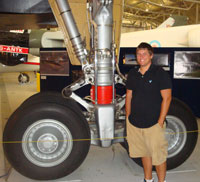 (Check out the picture of me by the Concord landing gear!) The exact Concorde at the Museum was never used commercially, but was one of the testing planes used by the production company. In its testing it had set the record speed and the record transatlantic flight time for all the Concords. Also in this museum was a de Havilland Comet 4, B52 bomber, and tons of other really neat planes. The Imperial War Museum was definitely my favorite in England. Saturday (July 4) came and we were off to the Royal Air Force Museum in Hendon. Although military aviation interests me less, it was still top-notch. The displays in the museum were very interactive and held tons of good information. A lot of information was always appreciated as part of our work included filling out information sheets on aircraft and how they affected aviation and the world. With the information sheets completed we would gather and do short presentations on our favorite planes. This was an effective and simple way to grasp an understanding of how important these planes were to their country’s development and protection.
(Check out the picture of me by the Concord landing gear!) The exact Concorde at the Museum was never used commercially, but was one of the testing planes used by the production company. In its testing it had set the record speed and the record transatlantic flight time for all the Concords. Also in this museum was a de Havilland Comet 4, B52 bomber, and tons of other really neat planes. The Imperial War Museum was definitely my favorite in England. Saturday (July 4) came and we were off to the Royal Air Force Museum in Hendon. Although military aviation interests me less, it was still top-notch. The displays in the museum were very interactive and held tons of good information. A lot of information was always appreciated as part of our work included filling out information sheets on aircraft and how they affected aviation and the world. With the information sheets completed we would gather and do short presentations on our favorite planes. This was an effective and simple way to grasp an understanding of how important these planes were to their country’s development and protection.